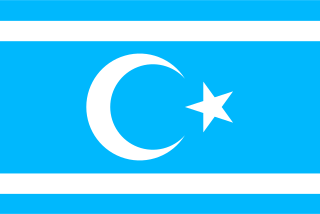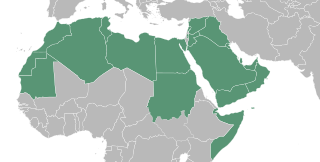
Turkish people or Turks are the largest Turkic people who speak various dialects of the Turkish language and form a majority in Turkey and Northern Cyprus. In addition, centuries-old ethnic Turkish communities still live across other former territories of the Ottoman Empire. Article 66 of the Turkish Constitution defines a Turk as anyone who is a citizen of Turkey. While the legal use of the term Turkish as it pertains to a citizen of Turkey is different from the term's ethnic definition, the majority of the Turkish population are of Turkish ethnicity. The vast majority of Turks are Muslims and follow the Sunni faith.
Minorities in Iraq include various ethnic and religious groups.

Anti-Turkish sentiment, also known as Anti-Turkism, or Turkophobia is hostility, intolerance, or xenophobia against Turkish people, Turkish culture and the Turkish language.

Kurdification is a cultural change in which people, territory, or language become Kurdish. This can happen both naturally or as a deliberate government policy.

The Turkish diaspora refers to ethnic Turkish people who have migrated from, or are the descendants of migrants from, the Republic of Turkey, Northern Cyprus or other modern nation-states that were once part of the former Ottoman Empire. Therefore, the Turkish diaspora is not only formed by people with roots from mainland Anatolia and Eastern Thrace ; rather, it is also formed of Turkish communities which have also left traditional areas of Turkish settlements in the Balkans, the island of Cyprus, the region of Meskhetia in Georgia, and the Arab world.

Nazımiye is a municipality (belde) and seat of the Nazımiye District of Tunceli Province in Turkey. It had a population of 1,262 in 2021.

The Iraqi Turkmen, also referred to as Iraqi Turks, Turkish-Iraqis, the Turkish minority in Iraq, and the Iraqi-Turkish minority are Iraq's third largest ethnic group. They make up to 10%–13% of the Iraqi population and are native to northern Iraq. Iraqi Turkmen share ties with Turkish people, and do not identify with the Turkmen of Turkmenistan and Central Asia.
Syrian Turkmen are Syrian citizens of Turkish origin who mainly trace their roots to Anatolia. Turkish-speaking Syrian Turkmen make up the third largest ethnic group in the country, after the Arabs and Kurds respectively.
Kouloughlis, also spelled Koulouglis, Cologhlis and Qulaughlis was a term used during the period of Ottoman influence in North Africa that usually designated the mixed offspring of Ottoman officials and janissaries, and local North African women.

The Arab world consists of 22 states. As of 2021, the combined population of all the Arab states was around 475 million people.

The Turkish communities in the former Ottoman Empire refers to ethnic Turks, who are the descendants of Ottoman-Turkish settlers from Anatolia and Eastern Thrace, living outside of the modern borders of the Republic of Turkey and in the independent states which were formerly part of the Ottoman Empire. Thus, they are not considered part of Turkey's modern diaspora, rather, due to living for centuries in their respective regions, they are now considered "natives" or "locals" as they have been living in these countries prior to the independence and establishment of the modern-nation states.
Turks in Denmark, also referred to as Turkish Danes or Danish Turks refers to ethnic Turkish people living in Denmark. They currently form the largest ethnic minority group in the country; thus, the Turks are the second-largest ethnic group in Denmark, after the ethnic Danish people. The majority of Danish Turks descend from the Republic of Turkey; however, there has also been significant Turkish migration from other post-Ottoman countries including ethnic Turkish communities which have come to Denmark from the Balkans, the island of Cyprus, and more recently Iraq and Syria.

Ethnic groups in the Middle East are ethnolinguistic groupings in the "transcontinental" region that is commonly a geopolitical term designating the intercontinental region comprising West Asia without the South Caucasus, and also comprising Egypt in North Africa. The Middle East has historically been a crossroad of different cultures and languages. Since the 1960s, the changes in political and economic factors have significantly altered the ethnic composition of groups in the region. While some ethnic groups have been present in the region for millennia, others have arrived fairly recently through immigration. The largest socioethnic groups in the region are Egyptians, Arabs, Turks, Persians, Kurds, and Azerbaijanis but there are dozens of other ethnic groups that have hundreds of thousands, and sometimes millions of members.

The Turkish population refers to the number of ethnic Turkish people in the world. During the Seljuk (1037–1194) and Ottoman (1299–1923) eras, ethnic Turks were settled across the lands conquered by the two empires. In particular, the Turkification of Anatolia was the result of the Battle of Manzikert in 1071 and the formation of the Sultanate of Rum. Thereafter, the Ottomans continued Turkish expansion throughout the regions around the Black Sea and the Mediterranean Sea. Consequently, today the Turkish people form a majority in Turkey and Northern Cyprus. There are also significant Turkish minorities who still live in the Balkans, the Caucasus, the Middle East and the Levant, and North Africa.
The Turks in Egypt, also referred to as Egyptian Turks, Turkish-Egyptians and Turco-Egyptians are Egyptian citizens of partial or full Turkish ancestry, who are the descendants of settlers that arrived in the region during the rule of several Turkic dynasties, including: the Tulunid (868–905), Ikhshidid (935–969), Mamluk (1250–1517), and Ottoman eras. Today their descendants continue to live in Egypt and still identify as Egyptians of Turkish or mixed origin, though they are also fully integrated in Egyptian society.
Turks in Jordan, also known as Turkish Jordanians or Jordanian Turks and Jordanian Turkmen, are people of Turkish ancestry living in Jordan. These people have had a thriving presence in Jordan since the rule of the Ottoman Empire. Today, there is a minority of about 60,000 people in the country who are the descendants of the Ottoman-Turkish immigrants. In addition to this, there are also 8,262 Turkish citizens who are recent migrants to Jordan.
Lebanese Turkmen, also known as the Lebanese Turks, are people of Turkish ancestry that live in Lebanon. The historic rule of several Turkic dynasties in the region saw continuous Turkish migration waves to Lebanon during the Tulunid rule (868–905), Ikhshidid rule (935–969), Seljuk rule (1037–1194), Mamluk rule (1291–1515), and Ottoman rule (1516–1918).
Turks in Yemen, also known as Turkish Yemenis and Yemeni Turks, refers to the ethnic Turks who live in Yemen.
Arabs in Romania are people from Arab countries who live in Romania. The first Fellah settlers came in 1831 - 1833 from Ottoman Syria to Dobruja. They assimilated in the Turkish-Tatarian Population. Some of them came to Romania during the Ceaușescu era, when many Arab students were granted scholarships to study in Romanian universities. Most of them were Algerians, Syrians, Palestinians, Iraqis, Libyans, Egyptians, and Yemenis. Most of these students returned to their countries of origin, but some remained in Romania starting families here. It is estimated that almost half a million Middle Eastern Arabs studied in Romania during the 1980s. A new wave of Arab immigration started after the Romanian Revolution. Many of the newly arrived Arabs came to Romania in the 1990s in order to develop businesses. In addition, Romania has people from Arab countries who have the status of refugees or illegal immigrants, primarily from North Africa, trying to immigrate to Western Europe. In particular, the European migrant crisis lead to Syrian people coming to Romania, although many Syrians were already living in Romania at the time of the crisis.

Syrians in Turkey, includes Turkish citizens of Syrian origin, Syrian refugees, and other Syrian citizens resident in Turkey. As of January 2024, there are approximately 3,200,000 registered refugees of the Syrian Civil War in Turkey, which hosts the biggest refugee population in the whole world. In addition, almost 80,000 Syrian nationals reside in Turkey with a residence permit. Apart from Syrian refugees under temporary protection and Syrian citizens with a residence permit; 238,055 Syrian nationals acquired Turkish citizenship as of December 2023.









